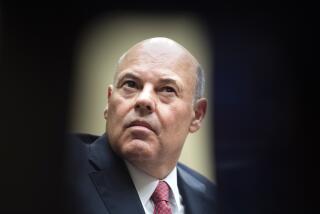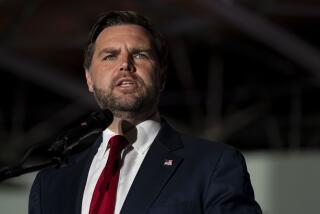Column: Trump says the Postal Service is ‘dumber and poorer,’ but he and Congress deserve the blame

Taking advantage of his prerogative to comment on issues of government about which he has no apparent knowledge, President Trump last week Twitter-attacked the U.S. Postal Service. A contract under which the USPS delivers packages for Amazon is “making Amazon richer and the Post Office dumber and poorer,” he tweeted.
The Dec. 29 tweet did cause experts to consider just what has made the USPS “poorer.” (The entity that delivers the U.S. mail hasn’t been formally known as the “Post Office” since 1971, when it was partially privatized.)
For the record:
2:45 p.m. Jan. 2, 2018An earlier version of this article indicated there were 103,656 pieces of first-class mail delivered in 2001 and the volume fell to 58,747 in 2017. There were 103.7 billion first-class letters delivered in 2001 and 58.7 billion delivered in 2017.
Short answer: It isn’t Amazon, which like FedEx, UPS and other parcel services, often uses the USPS to make last-mile deliveries of its parcels to homes and businesses. Trump’s intention may not have been a full-frontal attack on the Postal Service anyway: Many Trump-watchers believe he was just airing a grievance against Jeff Bezos, Amazon’s founder and CEO and proprietor of the Washington Post, one of Trump’s least favorite news sources.
The Postal Service cost structure is in many ways dictated by Congress. But Congress provides no funding support.
— James S. O’Rourke, University of Notre Dame
So who’s the guilty party? There are two: (1) Congress and (2) President Trump.
“The Postal Service cost structure is in many ways dictated by Congress,” James S. O’Rourke, an expert on the agency at Notre Dame law school, told me. “But Congress provides no funding support. It just governs many of the practices the USPS is obligated to follow.”
Those practices fall into two categories: political (with a small “p”) and fiscal. The political side of things is that paring back postal services is feared by lawmakers as an almost certain vote-loser. The USPS is one of those agencies that everyone loves to curse, but everyone prefers to have around. A 2011 proposal by the service to close 3,600 supposedly underused post offices created such an uproar that the plan barely survived into 2012 before being abandoned. These days, the only initiatives Congress dares to take regarding local post offices, O’Rourke says, is to pass resolutions naming them after local luminaries.
A subsequent proposal to end Saturday letter delivery also died a miserable death under congressional opposition. The USPS’ ability to carry letter mail even to the farthest reaches of the U.S., regardless of the cost, is a matter of national pride; the establishment of “post offices and post roads” is one of the enumerated responsibilities reserved to Congress under Article 1 of the Constitution.
So Congress demands a high level of service, then flays the USPS when it can’t provide such service without losing money.
Where does Trump fit in? As president, he has the power (with Senate consent) to appoint members of the Postal Service’s board of governors, which has the authority to set policies and rates. The nine governors serve seven-year terms. At the moment, there are nine vacancies, which explains why the board has a bit of a problem assembling a quorum.
Trump isn’t alone in neglecting the board: The last member’s term expired in December 2016, so obviously President Obama also let the issue slide. But Obama wasn’t tweeting that the service was “dumber and poorer.”
It’s true, as Trump tweeted, that the Postal Service loses billions of dollars a year — a net loss of $2.7 billion on revenue of about $70 billion in fiscal 2017, according to its latest annual report. Some of that is the harvest of the long-term decline in what used to be its bread and butter, the delivery of first-class mail. First-class volume peaked at 103.7 billion pieces annually in 2001. As Americans switched to automatic bill payment, email and even e-vites, volume fell more than 43% by fiscal 2017, to 58.7 billion.
Parcel deliveries have more than taken up the slack in volume, rising by 20% in the number of pieces and 40% in weight in the last three years. But delivering parcels also can be more expensive than letters. They require additional heavier trucks, more personnel and more fuel. And although the USPS is collecting more in revenue from packages than it used to, that still is not taking up the slack from the falloff in letter revenue.
The USPS expects revenue to rise by about a half-billion dollars in fiscal 2018, entirely from gains in package deliveries. But first-class mail revenue will decline by about $800 million, even after a one-cent increase to 50 cents in the cost of mailing a letter, which will kick in later this month.
What the Postal Service’s critics (including Trump) almost never mention is that the real drag on its earnings is another congressional directive. I wrote in 2012 that the USPS’ fiscal crisis was “as artificial as they come” — it was the product of a 2006 congressional mandate that the service must prepay over the next 10 years all its future expected retiree healthcare benefits.
Those payments totaled $38 billion through 2011, with further installments of between $5.6 billion and $11.1 billion a year due through 2016. At least $34 billion is still owed, according to the annual report. Conservatives who maintain that the USPS should be operated profitably, like a private business, fail to explain why the service should be burdened with a prepayment mandate that its competitors don’t face.
As for the Amazon deal, an analysis by Citigroup, claiming that the USPS was being shortchanged by an average of $1.46 per Amazon parcel, made a big splash last year, especially after it was trumpeted in the Wall Street Journal by a FedEx shareholder, who plainly thought FedEx was getting rooked. But Amazon responded that it wasn’t getting a special deal, and the basis for Citigroup’s estimate has remained murky.
All this begs the question of why the USPS should be required to turn a profit delivering the mail, whether by letter or package. Mail delivery in the terms that Americans tend to expect — a visit to the mailbox six days a week, no matter where it is, and flat-rate delivery from coast to coast, up to Alaska and out to Hawaii whether in snow or rain or heat or gloom of night — can’t be made profitable except at prices that would hit the average American where he and she lives, in the pocketbook.
Mail delivery falls squarely into the category of services whose marginal costs should be covered by government, which means all of us. The cost of mailing a letter has remained amazingly stable, adjusted for inflation, for nearly 100 years. In 1919, it was two cents for the first ounce, following a one-penny reduction instituted during World War I. That two cents would have the buying power of 50 cents today — which is what a first-class letter will cost starting Jan. 21.
That’s the marvel of U.S. postal delivery: In the 229 years since the Constitution placed its responsibility in the hands of Congress, it remains a public service binding this disparate country into one. Trump in his tweet said the Postal Service “should be charging MUCH MORE” to Amazon. Who exactly does he think would be paying that price?
Keep up to date with Michael Hiltzik. Follow @hiltzikm on Twitter, see his Facebook page, or email [email protected].
Return to Michael Hiltzik’s blog.
More to Read
Inside the business of entertainment
The Wide Shot brings you news, analysis and insights on everything from streaming wars to production — and what it all means for the future.
You may occasionally receive promotional content from the Los Angeles Times.










